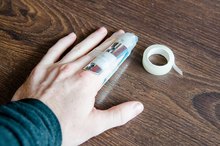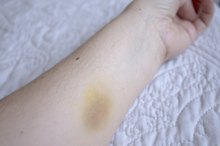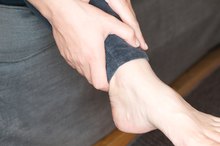How To Tell If An Ace Bandage Is Too Tight
Ace bandages can be used to provide protection and support for injured ankles, knees, arms or wrists. These types of bandages flex easily to conform to the body and compress injured areas to encourage healing. Wrapping a body part with an Ace bandage requires close attention to the task of winding the bandage to prevent an overly tight wrap. A properly wrapped Ace bandage helps reduce injury, pain and swelling. An improperly wrapped bandage can make an injury more painful and result in increased swelling and discomfort.
If you are experiencing serious medical symptoms, seek emergency treatment immediately.
Examine the wrapped area for any discoloration of the toes, fingers or arm beyond bruising from the initial injury. An overly tight bandage can compress the skin to create a blue or purple tinge to the skin.
How To Splint a Finger
Learn More
Assess how the injured body part feels. If you feel tingling, buzzing or numbness, the bandage is wound too tight.
Evaluate whether your skin has enough room to breathe under the bandage. Ace bandages should be worn snugly but not tight enough to cut off circulation. You should be able to slide one finger under the bandage to ensure a proper fit.
How to Heal Broken Skin Fast
Learn More
Evaluate whether the bandage is supporting your injury adequately, or if it's interfering with movement. A tightly wound bandage can limit range of motion unnecessarily.
Properly wrap the bandage around your injury, overlapping about half the bandage width with each turn. This layering provides gentle compression while still allowing plenty of range of motion. Cornell University's Gannett Health Services doesn't recommend extending the bandage over the fingers and toes 2.
Check the security of the clips that hold the bandage in place. These tiny clips can pull the bandage too tight, causing discomfort from cut-off circulation.
Remove the bandage a few times each day to encourage blood flow to the injury and release compression. Rewrap the bandage after 15 to 20 minutes. Make sure to have your physician's approval for removing the bandage.
Warnings
Contact your doctor if you feel increased pain after applying an Ace bandage. Your doctor should address any pain or cramping. If you've wrapped your injury too tightly and numbness or discoloration doesn't disappear relatively quickly, contact your physician for recommendations.
Related Articles
References
- Drugs.com
- Cornell University's Gannet Health Services
- Study Shows Most People Are Spreading Dangerous Bacteria Around the Kitchen and Don't Even Realize It. USDA. Jun 28, 2018.
- Surgical wound care - closed: MedlinePlus Medical Encyclopedia. MedlinePlus. Jun 11, 2018.
- Pickering D, Marsden J. Techniques for aseptic dressing and procedures. Community Eye Health. 2015;28(89):17.
- Smith SM, Zirwas MJ. Nonallergic reactions to medical tapes. Dermatitis. 2015;26(1):38-43. doi:10.1097/DER.0000000000000098
- Draelos ZD, Rizer RL, Trookman NS. A comparison of postprocedural wound care treatments: do antibiotic-based ointments improve outcomes?. J Am Acad Dermatol. 2011;64(3 Suppl):S23-9. doi:10.1016/j.jaad.2010.11.010
- Ozgok Kangal MK, Regan J-P. Wound Healing. Treasure Island, Fl: StatPearls Publishing; 2019.
Warnings
- Contact your doctor if you feel increased pain after applying an Ace bandage. Your doctor should address any pain or cramping. If you've wrapped your injury too tightly and numbness or discoloration doesn't disappear relatively quickly, contact your physician for recommendations.









